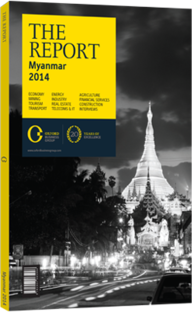A higher calibre: New standards are central to upcoming development
As demand for quality space in Yangon has multiplied since the lifting of sanctions, Myanmar’s construction industry has come under intense pressure to raise its standards and technical know-how. Local construction materials, equipment, expertise, workmanship, and safety of worksites and occupied buildings are all behind international standards to varying degrees. Most critically lacking is capacity to build tall buildings, which has become almost the only way to build in Yangon due to the high price of land. As U Thet Naing Shein, architect at Marvel Architects, told OBG, “The trend is to build high rises, but we do not have the construction technology or the specialists to go high. We only know the theory. We do not have the expertise.”
Yangon’s few existing high rises are the work of foreign firms partnered with local builders. For example, central Yangon’s Sakura Tower, completed in 1999, was built by Japan’s Konoike Construction partnered with A1 Group, a local developer-builder. U Thein Han, technical consulting engineer at A1 Group, said the firm’s experience working with Konoike and other foreign builders is a key advantage in the Yangon market.
Codifying Standards
For now, Myanmar’s engineers, architects and builders are focusing on improving more basic standards. A new building code was expected to be completed in 2014, based on a US model due to Myanmar’s use of English measures, but adapted to account for local materials and other realities, such as the low reach of local fire trucks.
U Win Khaing, president of the Myanmar Engineering Society, which is leading the drafting of the code, told OBG the code is aimed at improving the safety of both building sites and of residential developments. “A lot of the smaller apartment buildings that sprang up in the 1990s were built quite poorly,” he said. “There was no enforcement of standards or controls on materials. Many of these buildings have safety issues such as lack of fire prevention and fire exits.” The code is also meant to ensure structures are better able to withstand cyclones, a crucial issue following the major cyclone that hit the Irrawaddy Delta in 2008, killing 138,000.
Urban planning issues, such as minimum parking for taller buildings, are also addressed. U Win Khaing said worksite safety remains a problem, but standards of finished buildings are much improved. “The market is demanding higher quality. Builders are using much better materials and employing more foreign specialists, and local engineers are improving their expertise. New buildings must meet international fire safety standards.”
Daw Hlaing Maw Oo, the deputy chief architect at the Ministry of Construction, told OBG the government is also working on better regulating the architecture profession, including foreign architects. “We are working toward establishing a register of foreign architects, with an eye on cooperating within ASEAN on a register of architects licensed to work within the group.”
Improving Design
U Thet Nang Sein, who has worked on the building code as a member of the Association of Myanmar Architects, said the code would probably be difficult for domestic builders to comply with initially. However, he said it was an important step for setting minimum standards in all aspects of building, from structures to wiring. As for design, he said he is only just beginning to see project proposals that he finds interesting from an architectural point of view. The $440m complex of modern high rises being built in Yangon by Vietnam’s Hoang Anh Gia Lai Group “aren’t very interesting”, U Thet Nang Sein said. On the other hand, the high-end projects that predominate in Yangon are a far cry better than standard Yangon apartment blocks.
“Few of Yangon’s houses and apartment buildings involved an architect. That is why all the blocks look the same,” he said. U Thet Nang Sein mainly designs urban villa homes for developer First Myanmar Investment, a unit of Serge Pun & Associates. The villas sell for about $400,000, targeting the upper-middle class. Yet he admitted the homes are made to local tastes and not his own. He would prefer to be designing in the tropical modern style popular in Singapore, but “if I made something as modern as I like, it would be hard to sell.”
You have reached the limit of premium articles you can view for free.
Choose from the options below to purchase print or digital editions of our Reports. You can also purchase a website subscription giving you unlimited access to all of our Reports online for 12 months.
If you have already purchased this Report or have a website subscription, please login to continue.

